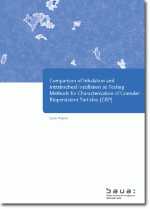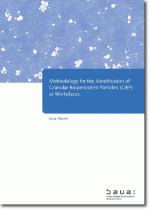Comparison of Inhalation and Intratracheal Instillation as Testing Methods for Characterisation of Granular Biopersistent Particles (GBP)
In this project F 2364 an in vivo validation study was conducted to evaluate the consistence of data with results obtained in the preceding intratracheal instillation study in project F 2336. The same test items were used and similar lung loads were achieved by calculating the target values after inhalation with the MPPD model. This approach served as a proof whether the instillation can be a reliable surrogate instead of the physiological inhalation route while assessing the GBP status of dust samples.
Comparison of bronchoalveolar lavage fluid (BALF) data
The comparison of the inflammatory potency of the 6 GBP candidates came out with a good accordance of the polymorphonuclear neutrophil (PMN) levels in the differential cell count for µ-TiO2. On day 3 post-treatment, PMN were not increased statistically significantly in the low and high dose groups, neither after instillation nor after inhalation. Thus, a very low inflammogenicity confirmed µ-TiO2 as GBP. µ-BaSO4 (low dose groups) showed a behaviour similar to µ-TiO2. However, for nano-TiO2 P25 an evident difference was observed as a strong induction of PMN after instillation was not mirrored after inhalation. µ-Eu2O3, µ-ZrO2 and nano-SiO2 showed all a strong acute inflammation not meeting this GBP criterion.
Comparison of chemical analysis data of the lung burdens
Post-instillation, an average retention of approx. 70% of the total dose was analytically detected; therefore, the target lung loads for the inhalation study were calculated at this day 3 dose level using the MPPD model. The analysis revealed that these values were achieved satisfactorily in average. The clearance half-time showed a value close to the physiological rat lung clearance of approx. 60 days in both µ-TiO2 "Bayertitan T" dose groups and in the nano-TiO2 P25 low dose group; in the latter high dose group t1/2=100 days was only moderately increased (overload effect). In the µ-BaSO4 and amorphous silica groups, values similar to the instillation test were observed (25-30 days; low values indicating an additional dissolution effect). In the µ-Eu2O3 and µ-ZrO2 groups increased half-times vs. the physiological value (= 60 days) indicated a clear surface chemistry-related toxicity and clearance retardation.
Conclusion
Considering the percentual PMN as well as the absolute PMN concentrations, the predominant observation is that inhalation induced a smaller PMN influx (with exception of biosoluble µ-BaSO4 and nano-SiO2) at similar doses. This can be expected because of the physiological dust uptake and deposition by inhalation that is more gentle than intratracheal instillation (bolus effect!). Effects detected after instillation will not always allow a 'non inert' statement. The final setting of maximum tolerable clearance t1/2 and PMN levels to define the GBP category should include inhalation. Doses at instillation testing of nanoparticles should not exceed volumetric values of 0.3 µl (using the correct agglomerate density).
Bibliographic information
Title : Comparison of Inhalation and Intratracheal Instillation as Testing Methods for Characterisation of Granular Biopersistent Particles (GBP).
1. edition . Dortmund: Bundesanstalt für Arbeitsschutz und Arbeitsmedizin, 2018. pages: 63, Project number : F 2364, PDF file , DOI: 10.21934/baua:bericht20180823

